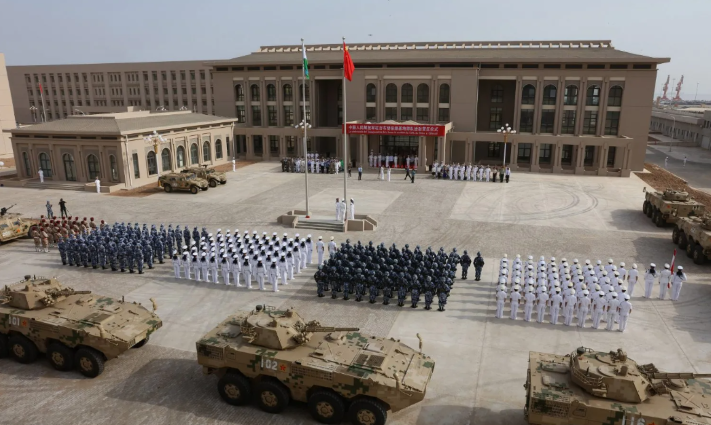 INTERNATIONAL DESK: China is rapidly constructing a new military facility along the western coastline of Africa, discloses AidData, a US-based think tank. According to the report, the location of Bata in Equatorial Guinea stands out as the most likely port for hosting a Chinese military base. Notably, the study reveals that China has already invested over $659 million in enhancing the port’s infrastructure at this site. The Commander of the U.S. Africa Command, General Stephen J. Townsend, said last year that Bata seemed to be where the Chinese regime had achieved the most significant progress in its expansion endeavours. The report also points to the inflow of financial resources and other forms of support from China to nations in West Africa, which could indicate ongoing efforts to execute such an expansion strategy.
INTERNATIONAL DESK: China is rapidly constructing a new military facility along the western coastline of Africa, discloses AidData, a US-based think tank. According to the report, the location of Bata in Equatorial Guinea stands out as the most likely port for hosting a Chinese military base. Notably, the study reveals that China has already invested over $659 million in enhancing the port’s infrastructure at this site. The Commander of the U.S. Africa Command, General Stephen J. Townsend, said last year that Bata seemed to be where the Chinese regime had achieved the most significant progress in its expansion endeavours. The report also points to the inflow of financial resources and other forms of support from China to nations in West Africa, which could indicate ongoing efforts to execute such an expansion strategy.
The report delves into the feasibility of China’s establishment of enduring international military installations to support its maritime forces, particularly the People’s Liberation Army Navy (PLAN). Creating offshore naval bases represents a coherent progression in China’s growing worldwide pursuits, as evidenced by endeavours such as the Belt and Road Initiative (BRI). These naval bases play a crucial role in securing vital sea lanes, fostering trade relationships, and advancing diplomatic interests. Presently, China possesses only a solitary recognised foreign naval base situated in Djibouti, which is in close proximity to a commerce-centric harbour developed and managed by China.
On the commercial front, China exercises unparalleled influence over the world’s oceans. It takes the lead in constructing most global shoreside infrastructure for commercial purposes, ranks among the top three shipbuilders for merchant vessels on a global scale, possesses the second-largest merchant fleet, and commands an extensive fishing armada. Furthermore, China engages in constructing and managing substantial terminal facilities across numerous ports worldwide. The level of authority the Chinese government would exert over its maritime assets during periods of conflict remains uncertain. However, it’s plausible that its expansive merchant and fishing fleets could be commandeered for military aspirations.
China’s naval capabilities have undergone a transformative shift, transitioning from a coastal force to a blue-water navy, emblematic of its aspirations for global power projection. The expansion of the People’s Liberation Army Navy (PLAN) encompasses the development of aircraft carriers, underscoring the nation’s enduring ambitions for continuous maritime operations beyond its borders.
China Requires New Bases to Sustain Global Presence
Developing additional bases in the more distant Pacific region or along the Atlantic coastline of Africa would significantly bolster China’s operational capacity. This move aligns with China’s objectives of extending its naval influence worldwide. Experts suggest that China is likely to invest in new overseas bases in the near future to facilitate a more extensive global military presence. This rationale underscores the Chinese government’s ongoing efforts in constructing carrier strike groups, which are envisioned to function like those of the United States.
China will need to establish supplementary naval bases abroad to effectively sustain these naval assets beyond its borders. This necessity arises despite its initial base in Djibouti, East Africa, established in 2017.
By establishing a fresh base on the western shores of Africa, precisely in Equatorial Guinea, China could effectively amplify its capability to furnish strike groups with essential resources like munitions and fuel. This move would also enable sustained and indefinite naval operations in the Atlantic region. Such a strategic placement at a considerable distance would empower them to effectively uphold military activities and maritime operations within the Atlantic theatre.
In pursuit of this objective, the report indicates that the government is expected to persist in enlarging its naval fleet in the upcoming decade. This increase in numerical strength will consequently create a need for fresh opportunities for overseas bases. The report emphatically underscores the impending and inevitable expansion of the Chinese navy over the next ten years, illuminating the intentions and plans of the Chinese authorities.
Chinese Naval Development Outstrips US
Anticipated within the next two years, China’s naval fleet is poised to surpass 400 vessels, thereby marking a substantial augmentation of its maritime capabilities, far surpassing the count of less than 290 vessels in the U.S. Navy. If it includes the Chinese coast guard and maritime militia forces, this count escalates to more than 600 vessels.
Moreover, while the U.S. nearly 300 warships are technologically more advanced than most of the Chinese fleet, only about a third of that force might be immediately available on any given day. That third is further spread across the globe. About 60 U.S. warships are deployed in the Indo-Pacific region and ready to face Chinese aggression on any given day. Meanwhile, the majority of the Chinese fleet is presently positioned within a 300-mile radius of the nation’s borders. This circumstance implies that the United States would find itself at a significant initial disadvantage in the event of a conflict unfolding in the Indo-Pacific region.
iNews covers the latest and most impactful stories across
entertainment,
business,
sports,
politics, and
technology,
from AI breakthroughs to major global developments. Stay updated with the trends shaping our world. For news tips, editorial feedback, or professional inquiries, please email us at
[email protected].
Get the latest news and Breaking News first by following us on
Google News,
Twitter,
Facebook,
Telegram
, and subscribe to our
YouTube channel.


